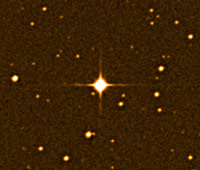 Gliese 581c. Sister Earth Astronomers detect the first Earth-like planet outside the solar system IF EXTRATERRESTRIAL life were to exist, it would need a planet on which to evolve. All but one of 200-or-so planets outside the solar system that have so far been discovered by astronomers would be quite unsuitable. That is because they are composed of gas. Yet the one whose discovery was announced this week is different. Astronomers think it is rocky, like the Earth, and that it may harbour liquid water. This makes it the best candidate yet for supporting life. The new planet orbits a star, called Gliese 581, that lies a mere 20 light years away in the constellation Libra. The temperature of the sun is such that it supports a nuclear-fusion reaction that generates bright sunlight. By contrast, Gliese 581 is a red dwarf, so-called because the star is small and the fusion reaction proceeds slowly, creating a dim glow. Nevertheless, because the new planet is much closer to its star than the Earth is to the sun, it lies in what astronomers call the “habitable zone”—the space surrounding a star where water would be in its liquid form. Seeing remote planets is difficult. Astronomers used to detect them indirectly, by spotting a small wobble in the position of the star, which indicated that it was being pulled very slightly to and fro by an orbiting planet. New telescopes and techniques have found other planets outside the solar system—so-called “exoplanets”—directly, from the slight dip in the luminosity of the star as the planet crosses its face. But these techniques work only with giant planets and, in general, giant planets are gaseous. Looking for planets orbiting red dwarfs is easier because the stars are less massive. This not only means that any planets are likely to circle it more closely (to remain in orbit) but also that the wobbles are more readily seen. The researchers—led by Stéphane Udry of the University of Geneva—used an indirect method called the “radial velocity” technique. This exploits the Doppler effect—familiar when a siren changes pitch as a fire engine passes you—to reveal changes in the velocity of the star as it wobbles. This is sensitive because it is easier to measure small changes in the wavelength of light than luminosity. The new planet, dubbed Gliese 581c, is more than three times the size of the Earth. It has five times the mass of this planet and orbits its star every 13 days. The astronomers who discovered it had earlier found another planet, a gaseous giant similar to Neptune, orbiting the same star every 5.4 days. They say they have strong evidence for a third planet in the same system that has about eight times the mass of the Earth and orbits every 84 days. The evidence is reported in a paper submitted to Astronomy and Astrophysics. According to theory, a planet the size and mass of Gliese 581c should be rocky, like the Earth. It could be covered in oceans, perhaps completely. The mean temperature on the surface of the planet is thought to be between 0°C and 40°C, making it far more hospitable than either Venus or Mars, Earth's nearest neighbours. The race is now on to detect whether the planet has an atmosphere and whether it contains water. Just a fortnight ago, astronomers using the Hubble space telescope identified for the first time water vapour in the atmosphere of an exoplanet, albeit a gaseous one some 150 light years away. The planet, called HD209458b, shows its face to Earth every three-and-a-half days, giving plenty of chances to take measurements. If water exists on Gliese 581c, detecting it there will be far harder. Even if Gliese 581c is not yet inhabited by little green men, there is plenty of time for that to change. The Earth gets its warmth from a sun that is thought to be about 5 billion years old and halfway through its lifetime as a “main sequence” star. After that it is expected to become a red giant, at which time the Earth's atmosphere and water will be boiled away, leaving it uninhabitable. Red dwarfs, by contrast, burn for hundreds of billions of years. This not only gives plenty of time for life to evolve on the recently discovered planet. It may make Gliese 518c a useful bolthole in some 5 billion years' time.
| 








